rhino drawing on 3d model produces lines on different planes
- Introduction
- Create your own 3D object
- Convert a 2D epitome into a 3D object
- Prepare your 3D object for 3D printing
3D Press Tutorial : Rhino 3D
Introduction
This 3D modeling software tutorial is written and designed to provide 3D press enthusiasts with accurate instructions for designing 3D files that are 3D Printable cheers to Rhino 3D CAD software.
In this 3D CAD tutorial, y'all volition acquire the best practices for modeling, correcting and exporting an object for 3D printing using Rhino software. At the end of this Rhino 3D tutorial, yous volition learn how to:
- Design a printable 3D file
- Manage and export valid 3D files for 3D printing from Rhino
- Avoid mistakes that occur when designing 3D files for 3D printing on Rhinoceros
So, you will be able to upload your 3D file on our website and 3D impress it!
Rhinoceros (Rhino) is a 3D modelling software specialized for free-course NURBS (non compatible rational B-spline), created by Robert McNeel & Associates. NURBS is a mathematical model that renders curves and surfaces in computers graphics. This mathematical model offers dandy flexibility and precision in 3D modelling.
Rhino is a CAD software commonly used for industrial design, architecture, marine design, jewelry pattern, automotive design, CAD / CAM, rapid prototyping, reverse applied science, production pattern, piece of furniture design, equally well as the multimedia and graphic design industries. Production pattern'south easy cheers to this 3D modeling tool. Rhino software is besides nifty to create CAD models for rapid prototyping with 3D printers. Indeed, Rhino models can be saved in a file format compatible with 3D printing.
A basic understanding of Rhinoceros is required in order to get the most out of this CAD software tutorial. Rhinoceros provides lots of swell videos and tutorials on its website forgetting started with Rhino.
You tin can purchase Rhino 3D or download a 90 days trial version of Rhinoceros V5 for gratuitous. You lot will too find some plugins for Rhino 3D that will assist you lot get a groovy Calculator-Aided design feel and create the best CAD models.
Rhino Models: Design a printable 3D file
1.1. Before starting to model
Before you kickoff 3D modelling annihilation using Rhinoceros there are some factors that should be considered.
Primal concepts for 3D modelling with Rhino
Rhino works with a 3D modelling category called NURBS which is different than regular mesh 3D modelling. However for 3D printing in Rhino it is still necessary to create a mesh subsequently the 3D modelling process. For this reason information technology is of import to continue in mind and analyze some bones 3D modelling concepts.
NURBS 3D modelling concepts
- Curve: are basically the points, lines and segments that make upward the sketch model.
- Surface: is a aeroplane without thickness created between a group of closed curves.
- Polysurface: is a set of multiple contiguous surfaces that build a volume.
- Solid: is a completely closed and joined polysurface that create the 3D model. Information technology is different from a mesh.
Mesh 3D modelling concepts
- Vertices: is a position along with other information such as colour, normal vector and texture coordinates.
- Edges: is a connection betwixt two vertices.
- Faces: is a closed set of edges that grade a airplane without thickness.
- Polygon: is a coplanar ready of faces that build an open up or a shut volume.
- Mesh: is a drove of vertices, edges and faces that define the shape of the 3D model. It is different from a solid.
A solid in Rhino is built with NURBS, which is different from a solid built through mesh 3D modelling. Knowing the difference between these two 3D modelling approaches is important for a successful 3D printable model.
Global 3D printing 3D modelling process with Rhino

Objet dimensions and measures compatibility
An important gene to consider before starting your 3D model is the size of the object relative to the professional person 3D printer that will be used to produce the piece. For case, if the model is bigger than the 3D printing area, the model must be adapted.
Also the desired dimensions of the slice should be coherent with the dimensions used while 3D modelling, every bit well as the units settings of the file that suits better to the projection (inches, centimetres, millimetres). This can be plant at 'File/ Properties/ Certificate Properties/ Units'.
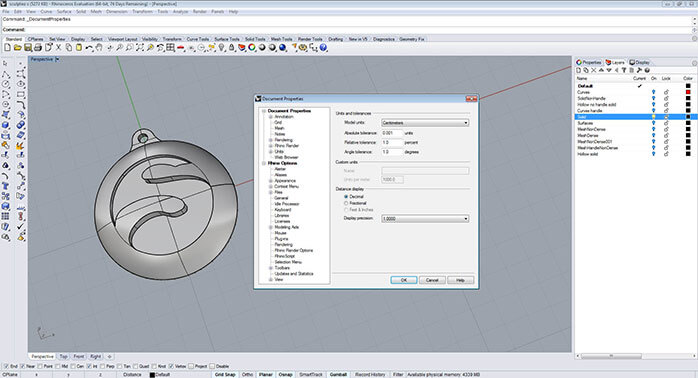
You tin can work with the nearly suitable units for you or for the project while 3D modelling. However earlier exporting you lot must ever switch the units to millimeters and allow Rhino to calibration the model.
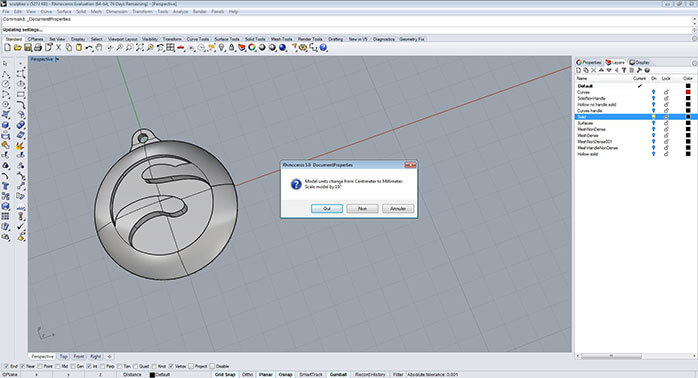
Rhino unit settings are ever interpreted as millimeters when imported into other programs. So, for example, if you modeled a office of 5 cm × five cm × 5 cm using centimeters as a unit, you will obtain measurements of v mm × 5 mm × 5 mm when exporting your model in STL. This is why y'all must change the units to millimeters no matter what unit of measurement of measurement you used to brainstorm your model.
Grid adjustment and measurement
It is important to be aware of the measures at all times while 3D modelling every bit this will permit you to have absolute control over the size of your model. The chief tool in Rhino used to visualize the size of your objects is the brandish grid in the background of the viewports. The filigree allows you to work precisely using the "Grid Snap" and the "Linear Dimension" tool.
You can gear up up and personalize your filigree at 'File/ Properties/ Certificate Properties/ Grid'.
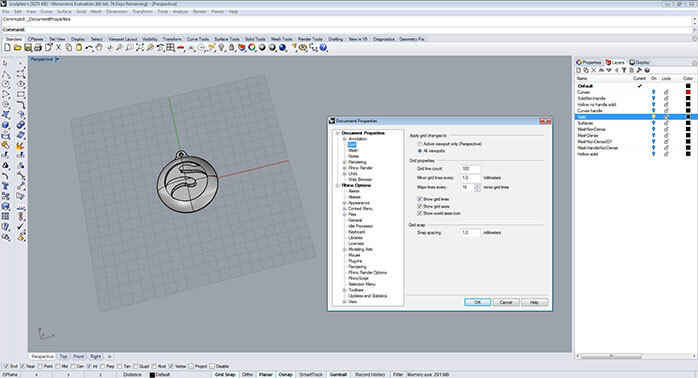
The "Linear Dimension" tool is Rhino'southward technical drawing tool and can be used to find a precise measurement of the model. You tin find it at Dimension/ Linear Dimension.
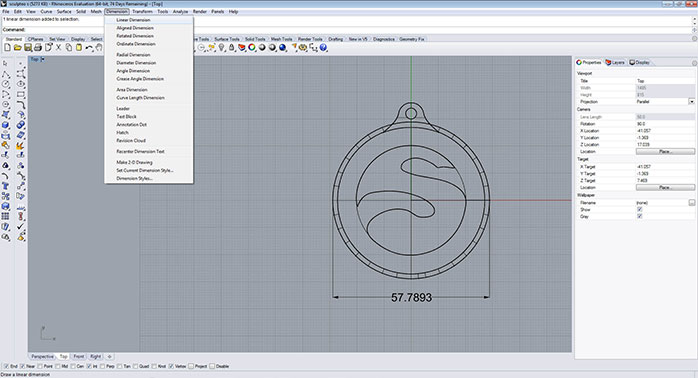
The dimension will appear on the arrows bar that was used to set up the file units, after selecting a starting and ending point for the line.
Tolerance settings
It is recommended to accept a expect at the tolerance settings file. This can exist found at 'File/ Properties/ Document Properties/ Units/ Accented Tolerance'.
The 3D file tolerance should be set depending on the model size and 3D modelling units. For example a 0.001 mm tolerance for a model with a size of 500 mm × 500 mm × 300mm will exist an exaggerated tolerance. Instead a 0.001 mm tolerance for a model with a size of 70 mm × 70 mm × 70mm will be reasonable.
This aspect is also relevant for the mesh creation that will be explained later in this tutorial.
Real time tool verification
It could exist too useful to turn on the Check New Objects tool by typing it in the control line "CheckNewObjects". This command volition constantly cheque every geometric effigy created to verify if it is valid (swell) and pops up a message when the figure created is corrupted.
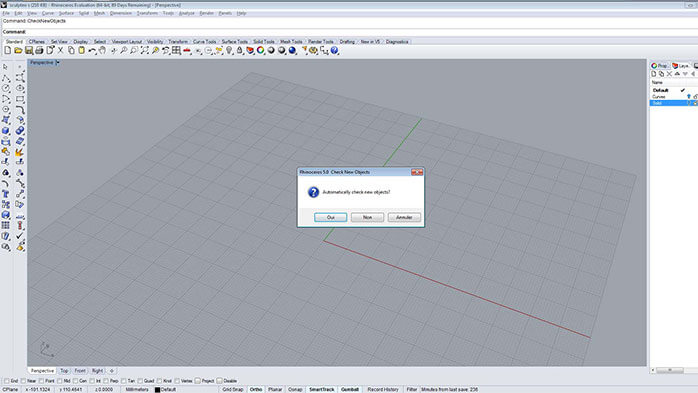
1.2. Proper 3D modelling for 3D print
When starting out with Rhino, as in any other 3D modelling software, it's essential to go on in listen that the 3D modelling characteristics for 3D press are different than your average rendering or animation model. Therefore split guidelines demand to be respected throughout the 3D modelling process in order to obtain a printable model. In this tutorial, various images are used to display the process – these images correspond with models that are most suitable with Sculpteo's plastic material. It is also important to note that Sculpteo uses Selective Laser Sintering (SLS) to 3D print plastic models. This tutorial takes both of those factors into consideration, however information technology is important to consider the specific material and manufacturing procedure that volition be used for your project while creating your model. For more data, you can refer to ourmaterials page. Next, yous will meet the precautions that must exist taken into business relationship to create correct solids during the 3D modelling phase. Watertight model While creating a 3D model it is important to sympathize that a 3D printable model must be "watertight" this means it should be designed to prohibit the entry of h2o. Most common mistakes using Rhino for 3D modelling that occur with non-printable models are the open polysurfaces, bad geometry and naked edges result in a not watertight model. Closed polysurfaces and non naked edges A closed polysurface is a set up of multiple contiguous surfaces that build a closed book called besides solids. Namely the volume walls accept no holes and they are all fastened. A model made of a closed polysurface will normally look like in the picture beneath. They are unremarkably built with Rhino'due south surface and solid menu operations .
. 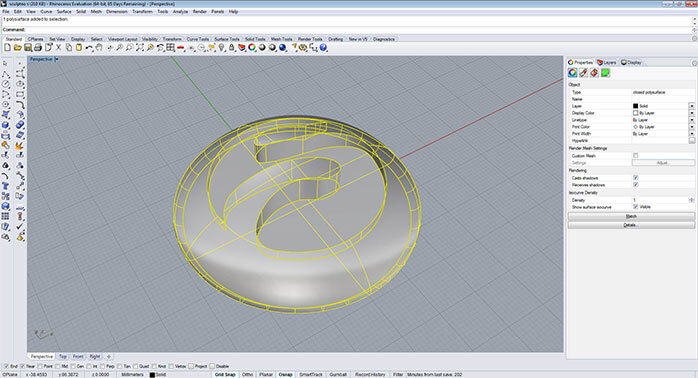 However you can besides (voluntarily or involuntarily) create models with an open up polysurface which are different than a models made with a closed polysurface. Most of the times, in this kind of model, y'all can appreciate the interior structure every bit shown in the movie below (cerise oval) but models like this are not 3D printable because, even if they exists, the surfaces have no thickness.
However you can besides (voluntarily or involuntarily) create models with an open up polysurface which are different than a models made with a closed polysurface. Most of the times, in this kind of model, y'all can appreciate the interior structure every bit shown in the movie below (cerise oval) but models like this are not 3D printable because, even if they exists, the surfaces have no thickness. 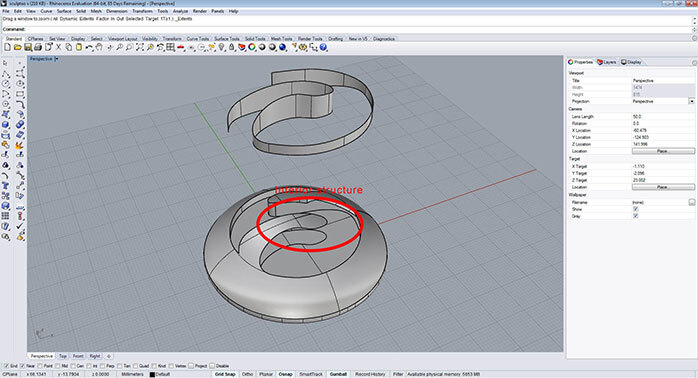 On the other paw, sometimes 3D models looks similar they are made with a airtight polysurface but they are non, this is what is chosen naked edges. A naked border is basically a surface edge that is not attached to another surface edge even if both surfaces are contiguous, consequently creating an open object. In the picture beneath you tin see a discrete surface selected that, when not selected, may look every bit a regular airtight object.
On the other paw, sometimes 3D models looks similar they are made with a airtight polysurface but they are non, this is what is chosen naked edges. A naked border is basically a surface edge that is not attached to another surface edge even if both surfaces are contiguous, consequently creating an open object. In the picture beneath you tin see a discrete surface selected that, when not selected, may look every bit a regular airtight object. 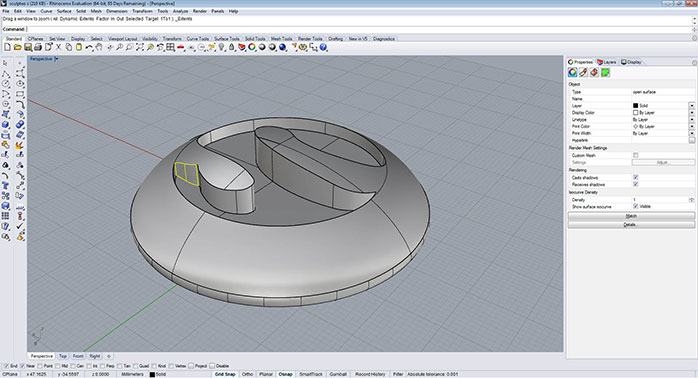 This could happen involuntary for many reasons, about of the times it's because of an unsuccessful 3D modelling performance like split, trim, rebuilding surfaces or the act of exploding and joining surfaces
This could happen involuntary for many reasons, about of the times it's because of an unsuccessful 3D modelling performance like split, trim, rebuilding surfaces or the act of exploding and joining surfaces  . This last one is paradoxical but true and it happens when multiple surfaces are joined at the same fourth dimension. Later using these operation it is ever recommended to verify the object (as you lot volition encounter further in this tutorial) because some surfaces may need to be joined separately to avoid creating naked edges which volition certainly be a problem during a 3D print. Valid object Valid objects are objects built without bad geometry errors. Bad geometry models or bad objects in Rhino are those who violate certain NURBS rules or accept a structural problem. Most often, the bad objects are surfaces in a solid, but bad curves as well happen occasionally also. This happens for many technical reasons, in a surface is unremarkably considering the trim curve is bad. This is not something you tin can make intentionally but it often happens subsequently bring together operations
. This last one is paradoxical but true and it happens when multiple surfaces are joined at the same fourth dimension. Later using these operation it is ever recommended to verify the object (as you lot volition encounter further in this tutorial) because some surfaces may need to be joined separately to avoid creating naked edges which volition certainly be a problem during a 3D print. Valid object Valid objects are objects built without bad geometry errors. Bad geometry models or bad objects in Rhino are those who violate certain NURBS rules or accept a structural problem. Most often, the bad objects are surfaces in a solid, but bad curves as well happen occasionally also. This happens for many technical reasons, in a surface is unremarkably considering the trim curve is bad. This is not something you tin can make intentionally but it often happens subsequently bring together operations  or other commands that also join objects like booleans operations
or other commands that also join objects like booleans operations  . These operations divide edges and conform trim curves that in some cases are smaller than the absolute tolerance of the file producing bad geometry. Material reduce There are several reasons why digital models for 3d printing are hollow but the primary reason is the corporeality of fabric that will be used to produce the model. In 3d press — unlike other production techniques — the cost of fabricating an object is not dictated by the complexity of its shape, but by the amount of cloth that is required to produce the design. Therefore, making your object hollow volition positively affect the manufacturing cost of 3D printing, by decreasing it to less than 60% or 70% of its initial price. Some other important reason to hollow a model, is keeping your product lightweight. For example if you already have a model and you would similar to rescale it to produce a different size of information technology you can hollow your model to arrive bigger but go along it light. But simply hollowing your model doesn't affect your production; the hollow interior must have at least 2 holes to the bleed the backlog press material. This is a restriction SLS' press process, without the holes to let the fabric drain it will be trapped within the physical object. The Sculpteo online uploader has recently been enriched with automated hollowing feature that allows you to handle the hollowing process online. This feature automatically generates the inner shell of your model letting you simply choose the required hole positions on your model. To learn more than about Sculpteo'due south new hollowing feature and try information technology at present, you tin canupload your 3D fileand click on "Optimize" tab after choosing your material. Next, you volition see how to hollow your model in order to reduce the material used during a 3D print. This will let for a bigger, lighter, and more than economical version of the object using Rhinoceros. Y'all have to offset scale the model to the desire size. Illustrated in this case the model is doubled in the size from 6 cm to 12 cm.
. These operations divide edges and conform trim curves that in some cases are smaller than the absolute tolerance of the file producing bad geometry. Material reduce There are several reasons why digital models for 3d printing are hollow but the primary reason is the corporeality of fabric that will be used to produce the model. In 3d press — unlike other production techniques — the cost of fabricating an object is not dictated by the complexity of its shape, but by the amount of cloth that is required to produce the design. Therefore, making your object hollow volition positively affect the manufacturing cost of 3D printing, by decreasing it to less than 60% or 70% of its initial price. Some other important reason to hollow a model, is keeping your product lightweight. For example if you already have a model and you would similar to rescale it to produce a different size of information technology you can hollow your model to arrive bigger but go along it light. But simply hollowing your model doesn't affect your production; the hollow interior must have at least 2 holes to the bleed the backlog press material. This is a restriction SLS' press process, without the holes to let the fabric drain it will be trapped within the physical object. The Sculpteo online uploader has recently been enriched with automated hollowing feature that allows you to handle the hollowing process online. This feature automatically generates the inner shell of your model letting you simply choose the required hole positions on your model. To learn more than about Sculpteo'due south new hollowing feature and try information technology at present, you tin canupload your 3D fileand click on "Optimize" tab after choosing your material. Next, you volition see how to hollow your model in order to reduce the material used during a 3D print. This will let for a bigger, lighter, and more than economical version of the object using Rhinoceros. Y'all have to offset scale the model to the desire size. Illustrated in this case the model is doubled in the size from 6 cm to 12 cm. 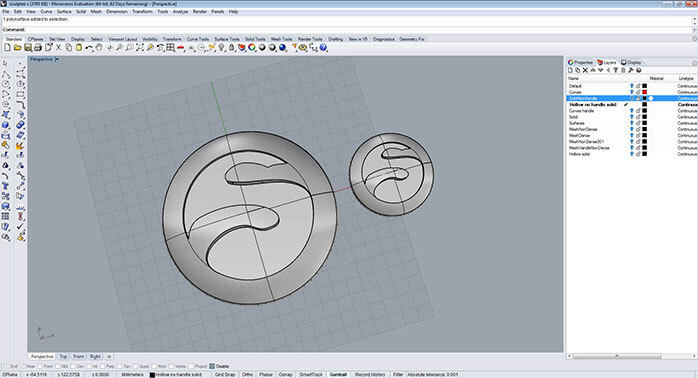 You should keep in heed that the minimum wall thickness for the Plastic material is 0.eight mm and the maximum wall thickness must exist coherent with the model size. An overly thick wall in a small object will produce geometry errors depending on the curvature of the interior of the model. It is recommended to try dissimilar wall thicknesses to find the best for your object. A rod made with Sculpteo'south polyamide plastic, for example, is rigid at 2 mm thick (check the material guide for more data well-nigh polyamide design guidelines). Once you have determined the right size you should excerpt a surface to arrive an open polysurface. For this you tin use the "Extract Surfaces" tool by typing "ExtractSrf" in the command line and selecting the chosen face up. So you tin can eliminate the face.
You should keep in heed that the minimum wall thickness for the Plastic material is 0.eight mm and the maximum wall thickness must exist coherent with the model size. An overly thick wall in a small object will produce geometry errors depending on the curvature of the interior of the model. It is recommended to try dissimilar wall thicknesses to find the best for your object. A rod made with Sculpteo'south polyamide plastic, for example, is rigid at 2 mm thick (check the material guide for more data well-nigh polyamide design guidelines). Once you have determined the right size you should excerpt a surface to arrive an open polysurface. For this you tin use the "Extract Surfaces" tool by typing "ExtractSrf" in the command line and selecting the chosen face up. So you tin can eliminate the face. 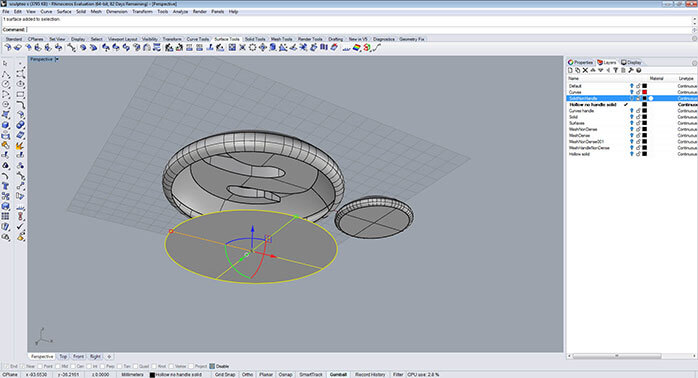 Later that you can use the "Offset Surface" tool
Later that you can use the "Offset Surface" tool  past clicking on it in the left bar menu under Filet Surface/ Starting time Surface or typing in the control bar "start srf". With the object selected, you lot plough on the option "Solid=aye", and set the "Distance" to your desired length (2 mm in this example). If you lot do non want the external course of the object to change you flip the offset direction to the interior of the model with "FlipAll". All this can exist done using the command bar.
past clicking on it in the left bar menu under Filet Surface/ Starting time Surface or typing in the control bar "start srf". With the object selected, you lot plough on the option "Solid=aye", and set the "Distance" to your desired length (2 mm in this example). If you lot do non want the external course of the object to change you flip the offset direction to the interior of the model with "FlipAll". All this can exist done using the command bar. 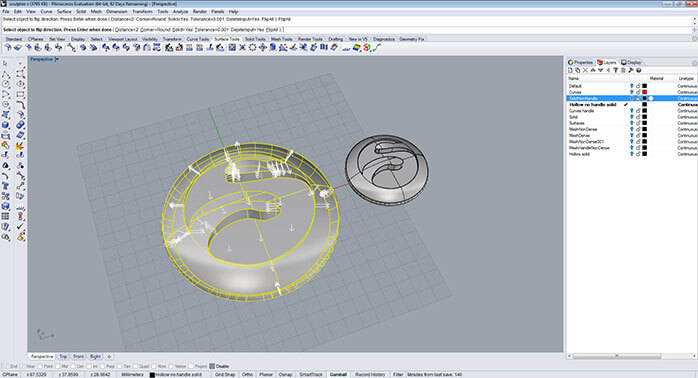 You will event in a solid (or closed polysurface model) with a uniform 2 mm wall thickness.
You will event in a solid (or closed polysurface model) with a uniform 2 mm wall thickness. 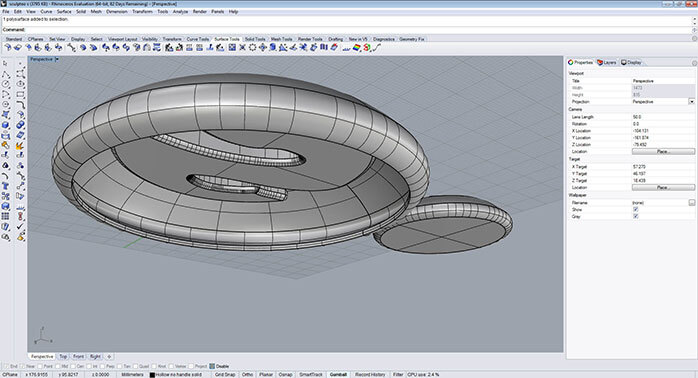 One single solid part Sometimes, the 3D modelling parts are made using many dissimilar solids that intersect each other which finally compose one single role.
One single solid part Sometimes, the 3D modelling parts are made using many dissimilar solids that intersect each other which finally compose one single role. 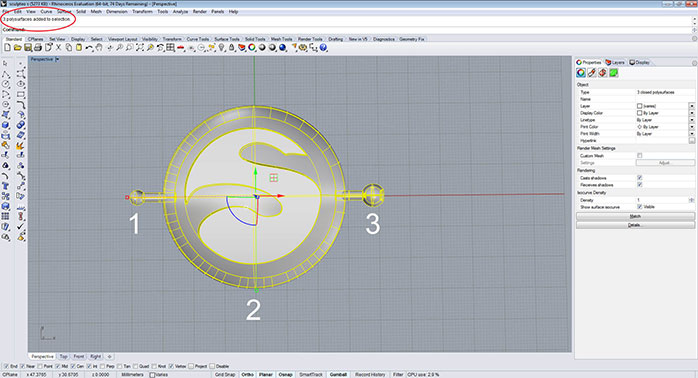 Even if the model is constructed with many different cubes or cylinders, the final slice should be a singular and compact solid in order for a successful 3D impress. When you select a single part of your model, you ordinarily should encounter in the control line "1 polysurface added to selection" this means your office has been added to the entire object.
Even if the model is constructed with many different cubes or cylinders, the final slice should be a singular and compact solid in order for a successful 3D impress. When you select a single part of your model, you ordinarily should encounter in the control line "1 polysurface added to selection" this means your office has been added to the entire object. 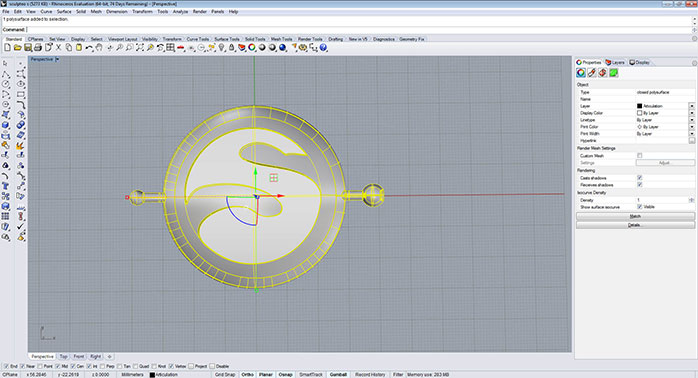 Also your model can be composed of unlike parts that do non intersect only are instead extremely, or even entrapped within some other object. This style of 3D modelling is particularly helpful when creating moving parts or other types of inserts, sockets, articulations, etc. In this case you have to keep in mind the 3D modelling tips for this kind of parts and understand that an articulation is made from two unmarried solids and not course an intersected solids.
Also your model can be composed of unlike parts that do non intersect only are instead extremely, or even entrapped within some other object. This style of 3D modelling is particularly helpful when creating moving parts or other types of inserts, sockets, articulations, etc. In this case you have to keep in mind the 3D modelling tips for this kind of parts and understand that an articulation is made from two unmarried solids and not course an intersected solids. 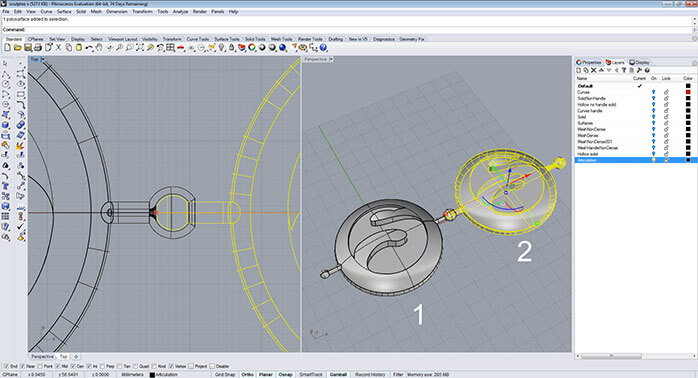 This is very important when producing a 3D printable file without errors. You can observe more data well-nigh articulations and design guidelines depending on the cloth on ourmaterials folio.
This is very important when producing a 3D printable file without errors. You can observe more data well-nigh articulations and design guidelines depending on the cloth on ourmaterials folio.
1.3. Color and textures for full colour press
Manage and export valid 3D files for 3D printing from Rhinoceros
2.1. 3D model analysis
When 3D
Open
The simplest manner to place an open 
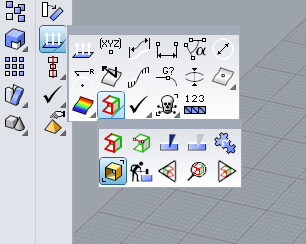
When an object is fabricated of an open
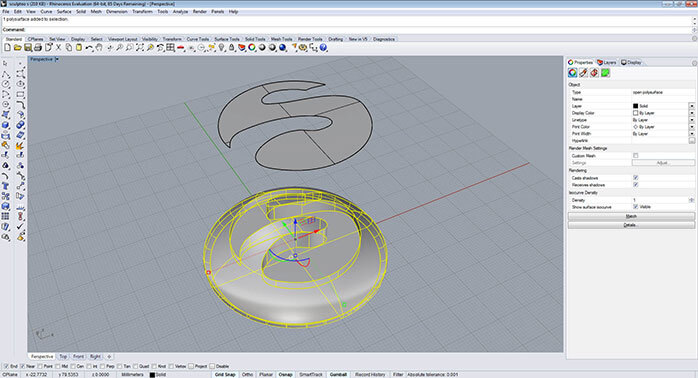
If the model stays closed, you will see "No objects added to choice" in the command line.
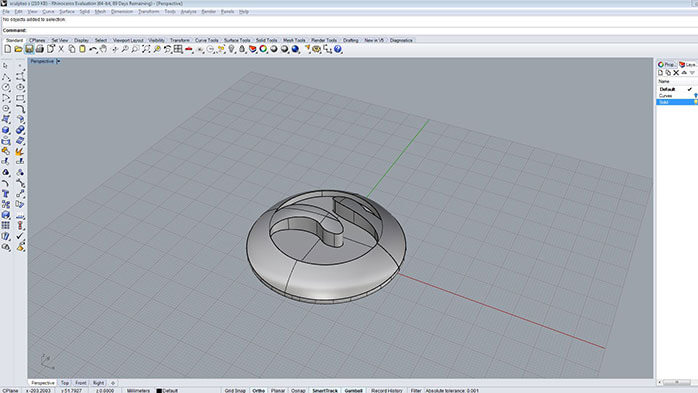
By doing this, you tin notice out which object is made of an open
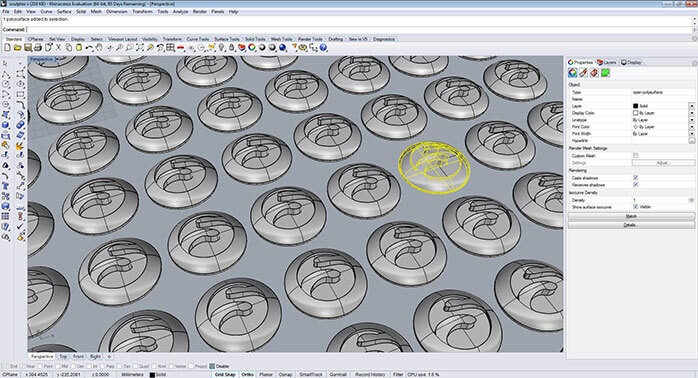
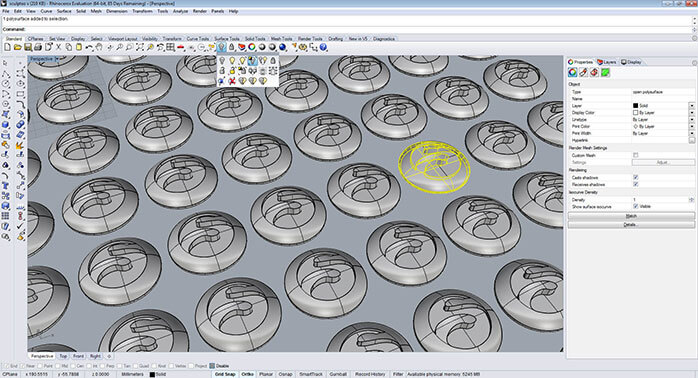
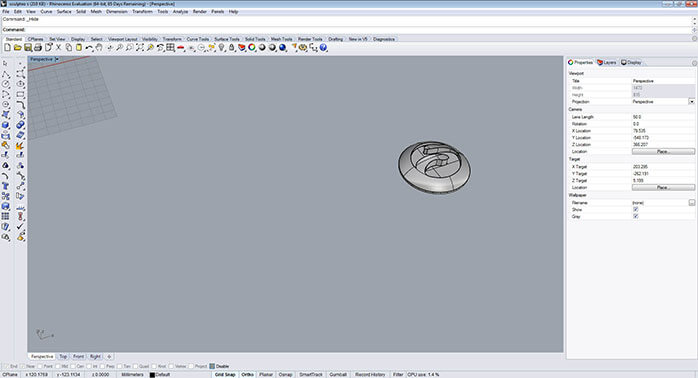
One time you have the isolated object you can keep to practise the naked edges detection.
Edge assay for naked edges
The edge analysis tool volition help you observe where and if a
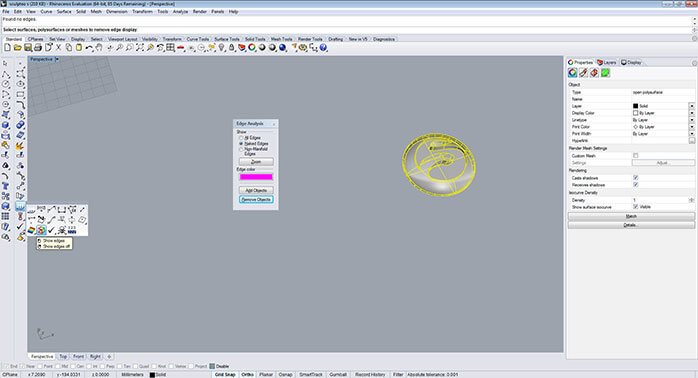
This command will light up the open contour according to the selection color in the edge analysis box.
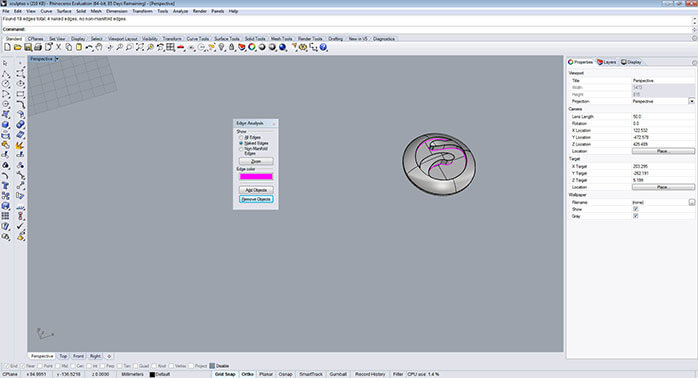
Bad geometry
The "select bad objects" 
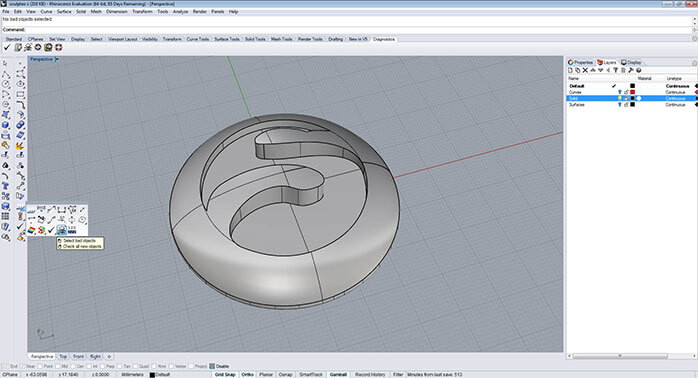
To have more than detailed information about a bad object, you can run a diagnostic using "Cheque objects"  bachelor in the main menu under 'Check objects'. A popup window will give yous more data about the model e.g. if there is whatsoever bad geometry or "Rhino
bachelor in the main menu under 'Check objects'. A popup window will give yous more data about the model e.g. if there is whatsoever bad geometry or "Rhino
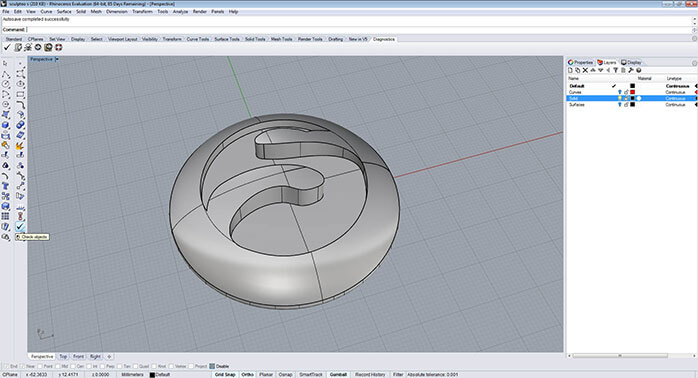
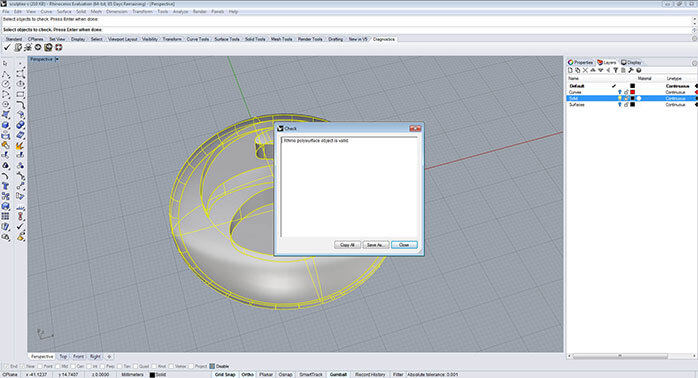
Y'all can select the model and become to properties in the right cavalcade to select 
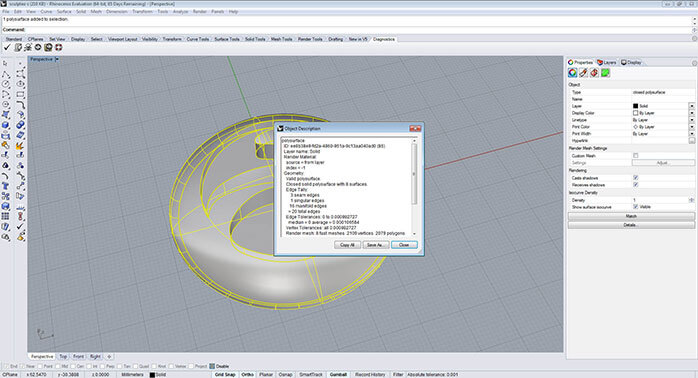
2.2. Set up NURBS 3D model
Repair naked edges After finding the naked edges, you can fix them with a bring together

Yous tin can then join the detached surface to the main torso of the model and close the object. 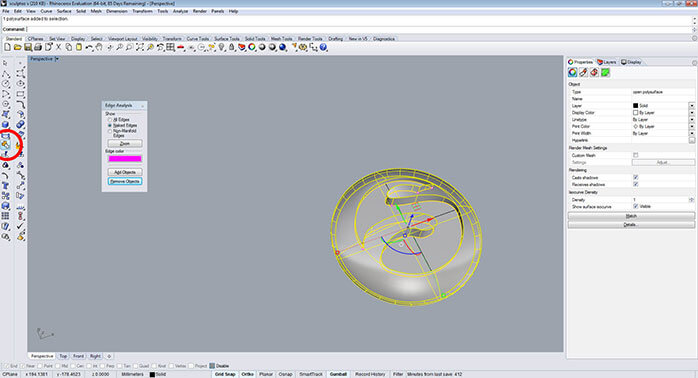 However, sometimes there are missing surfaces. In this case, the best method to solve the problem is to create a new surface that volition be in perfect contact with the surrounding surfaces edges; employ join to create a airtight
However, sometimes there are missing surfaces. In this case, the best method to solve the problem is to create a new surface that volition be in perfect contact with the surrounding surfaces edges; employ join to create a airtight
. When the surface edges are more than afar to each other than what your Rhino file tolerance allows -for example when two surface edges are 0.ane mm apart and Rhino tolerance is 0.001- the join command won't piece of work. This type of naked border can be fixed past using a forced union. If precision 3D modeling is non important for the 3D modeling work, this could be a quick fix operation. Information technology allows Rhinoceros to bring together the edges without taking the minimal tolerance into account. 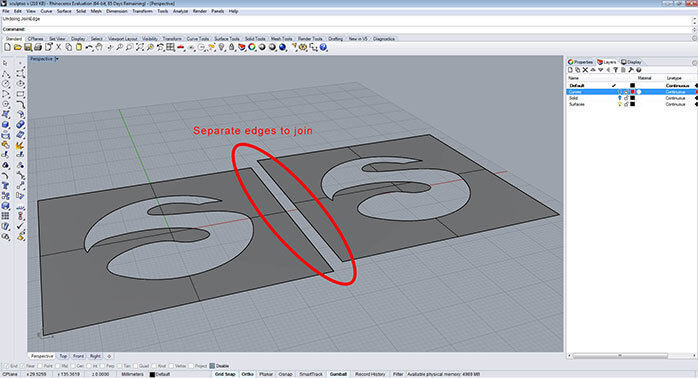 You can find the forced matrimony tool nether 'Surface menu/ Edge Tools/ Join 2 naked edges' or by typing "JoingEdge" into the control line.
You can find the forced matrimony tool nether 'Surface menu/ Edge Tools/ Join 2 naked edges' or by typing "JoingEdge" into the control line. 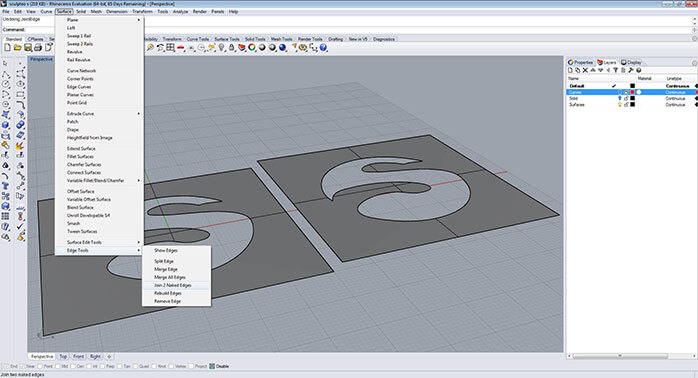
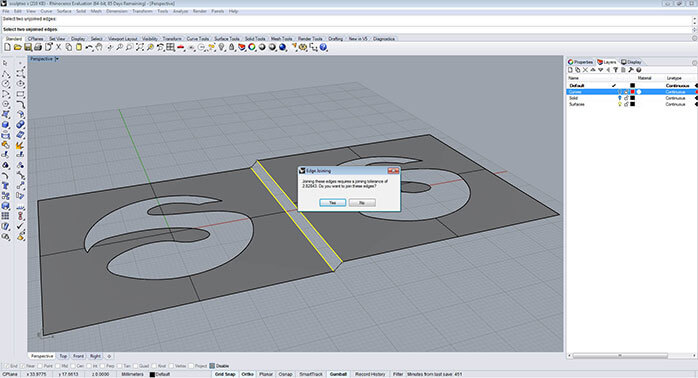
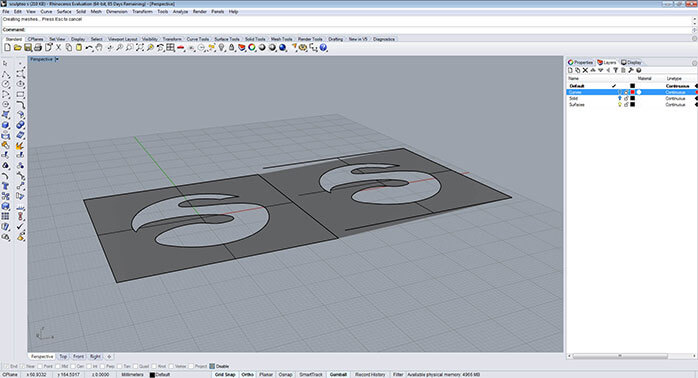 This is a quick solution, not the best ane, but it is better to accept a make clean closed
This is a quick solution, not the best ane, but it is better to accept a make clean closed
model. Practise note, the Bring together Edges operation may not work if yous are exporting the solid as an IGES or STEP file (to then be used for purposes other than 3D printing). Fixing bad geometry As was mentioned in the valid objects department, bad geometry is more often than not generated from bad surfaces due to an error that occurs during the adjusting of the trim bend. Usually, bad surfaces are stock-still by making the model explode and so rejoining it. If this does not set the model, information technology is considering there are complicated NURBs bug in the structure. You can try to set them with the post-obit tool operations:
Multiple solids model As explained earlier, in the "proper 3D
for 3D printing" department, your model or office should exist made out of one single solid or closed
. If this is not the case, you can select both solids and make one single solid using the tool "boolean union"  . This will fuse the ii solids into a single i. You tin can find this tool in the left bar or nether 'Solid/ Wedlock'.
. This will fuse the ii solids into a single i. You tin can find this tool in the left bar or nether 'Solid/ Wedlock'.
2.3. Create and export a mesh
As Rhino use a
approach for 3D
, you must produce a mesh in order to create a 3D print file. Yous can export the Rhino model
STL (stéréolithographie) from 'File/ Export Selected' and save it to create a 3D print file. 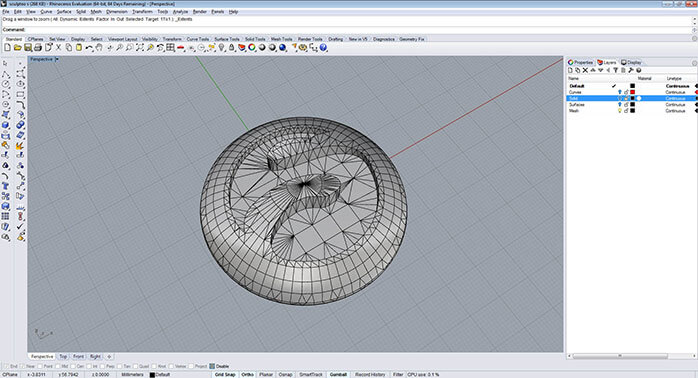 For obtaining optimal results, information technology is recommended to have a better understanding and control of the mesh creation settings before you outset exporting. You can create a mesh without exporting the solid by using the control "Mesh"
For obtaining optimal results, information technology is recommended to have a better understanding and control of the mesh creation settings before you outset exporting. You can create a mesh without exporting the solid by using the control "Mesh"  – located in the main left command bar – or by typing in the command line "Mesh". Right away a popup window will show with the "Polygon Mesh Options" along with some unproblematic controls. In order to accept more than control over the
– located in the main left command bar – or by typing in the command line "Mesh". Right away a popup window will show with the "Polygon Mesh Options" along with some unproblematic controls. In order to accept more than control over the
you lot will have to switch and fix "Detailed Controls". These controls volition allow y'all to prepare up the density and quantity of the mesh. Side by side, you volition see some tips to create the mesh that best suits your needs. 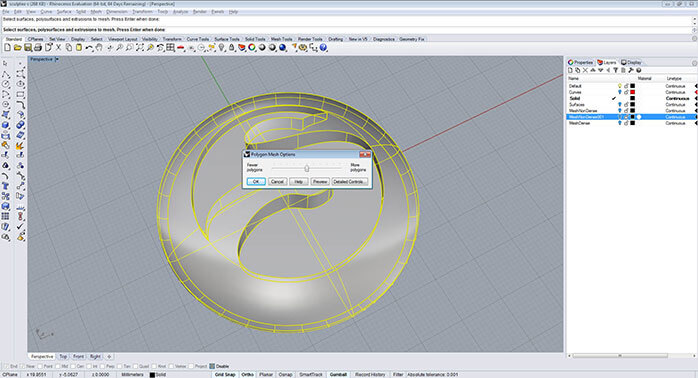
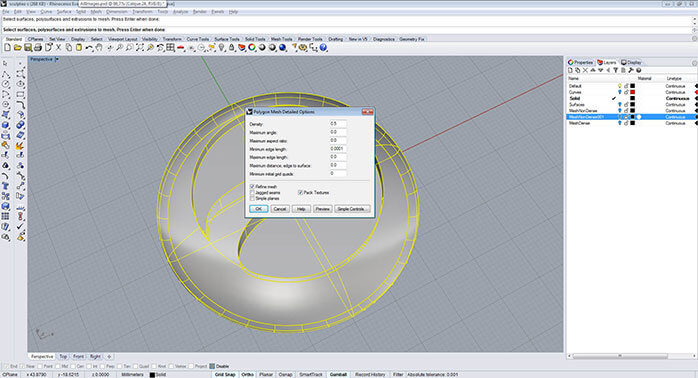 Tolerance for mesh creation A mesh is equanimous of many faces that actually brand up your model. The quantity of the faces depends on the mesh density. A model with few faces will look faceted or information technology will take a depression polygon appearance. A model with many faces will wait smooth and have a high polygon appearance. The more faces, the smoother your model will look but be careful considering an exaggerated number of polygons could turn your 3D model in an oversized file, making it more difficult to handle.
Tolerance for mesh creation A mesh is equanimous of many faces that actually brand up your model. The quantity of the faces depends on the mesh density. A model with few faces will look faceted or information technology will take a depression polygon appearance. A model with many faces will wait smooth and have a high polygon appearance. The more faces, the smoother your model will look but be careful considering an exaggerated number of polygons could turn your 3D model in an oversized file, making it more difficult to handle. 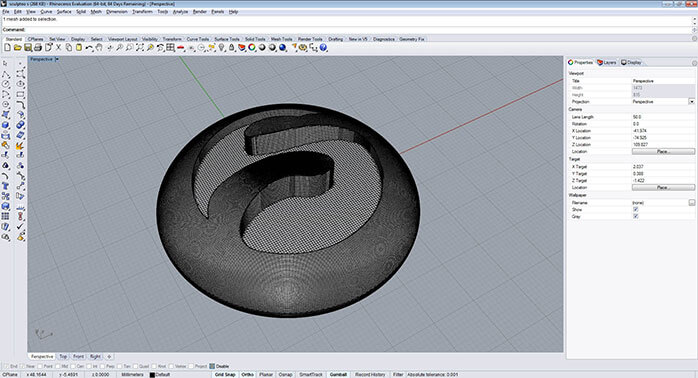
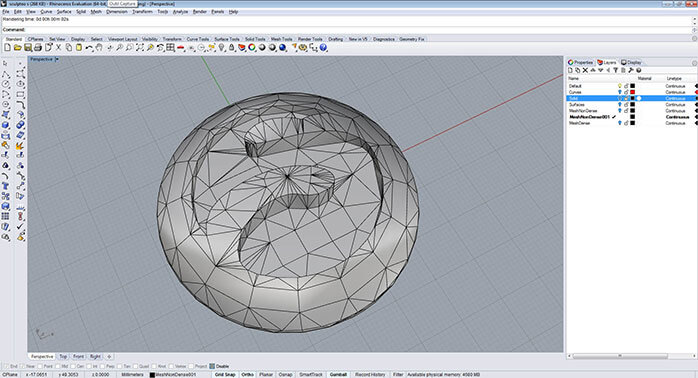 A expert 3D print mesh looks nearly black. The polygons distribution is organized and balanced within the model. A good example is the loftier polygon moving-picture show displayed higher up.
A expert 3D print mesh looks nearly black. The polygons distribution is organized and balanced within the model. A good example is the loftier polygon moving-picture show displayed higher up.
the polygons quantity must be conforming to the model size. For
an object of xxx mm × 30mm × 70 mm will exist printed with an optimal surface if you use betwixt 500.000 and 600.000 polygons and smaller objects like jewelry (rings, earrings or pendants) employ something close to 150.000 polygons for an optimal surface. The recommended values in a general manner to ready the tolerance for small-scale objects for 3D printing are the following.
- Density: 0.0
- Maximum angle: 0.0
- Maximum aspect ratio: 0.0
- Minimum edge length: 0.0
- Maximum edge length: 0.0
- Maximum altitude edge to
surface : "The same equally the tolerance file" (tolerance settings) - Maximum border length: 0.0
- Minimum initial filigree quads: "Variable depending on how the mesh looks"
The minimum initial grid is a variable value depending on your model. This number volition aid united states to define the number of quadrangles per surface in the initial mesh grid. Namely, the polygons quantity on each surface. Bigger values result in slower meshing, more accurate meshes and a higher polygon count with more evenly distributed polygons. For example a minimum initial
of 100 produces a mesh almost black and with a certain uniformity in the sides of the model,
the "S" interior is not actually compatible and it
many peaks and triangles creating a messy mesh. Instead, if you lot use a 7000 value the mesh will be more homogeneous and organized. That is why the minimum initial grids
variable depending on your model. 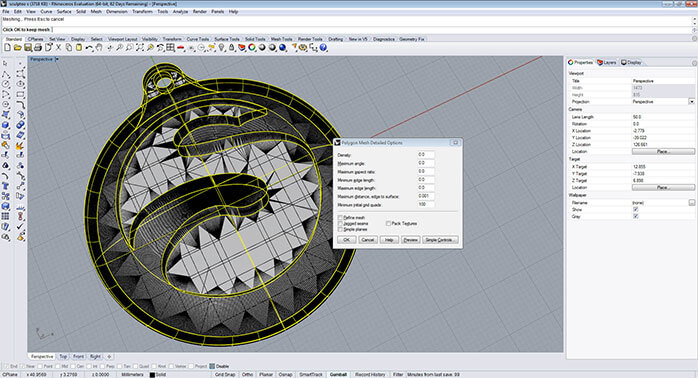
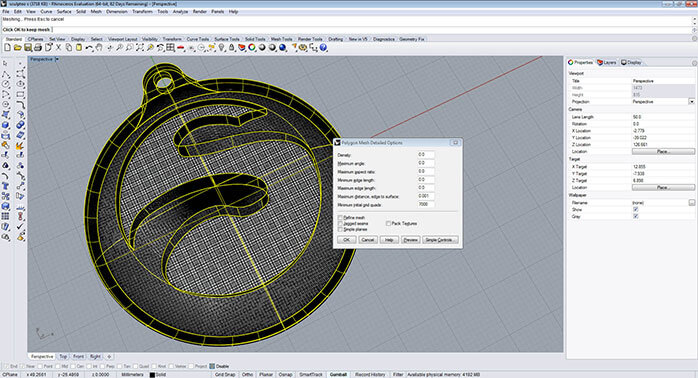 Afterwards the mesh
Afterwards the mesh
yous can separate the solid from the mesh and you will be able to check the number of polygons in the object. In order to this, select the mesh and apply the right column properties tab by clicking in the
"Details". You will the following within the mesh's general data: "closed polygons mesh and the number of polygons that etch the mesh". For example, in the model displayed below at that place is mesh with
minimum initial grids that accept 151667 polygons. This is a reasonable mesh for a model with this small size like jewelry objects (rings, earrings or pendants). 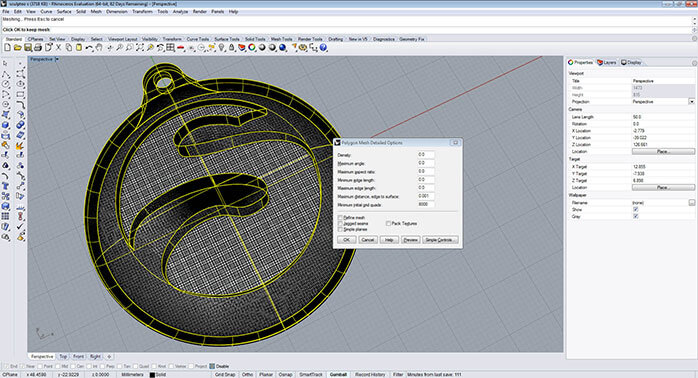
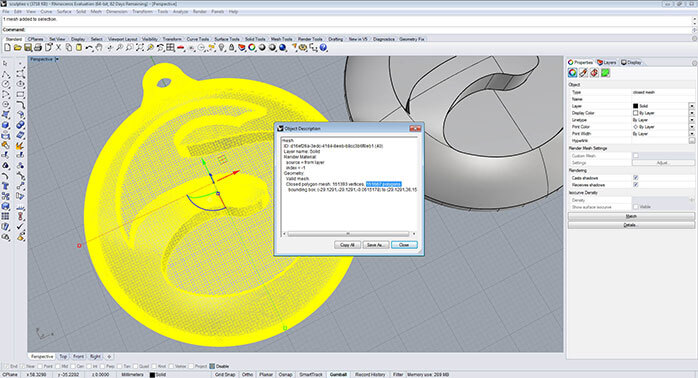
the model is gear up to be exported. Under 'File/ Export selected', choose the file emplacement and after
there volition be an ending window. Make sure yous uncheck the option "consign open objects" and leave Binary selected and then click ok. 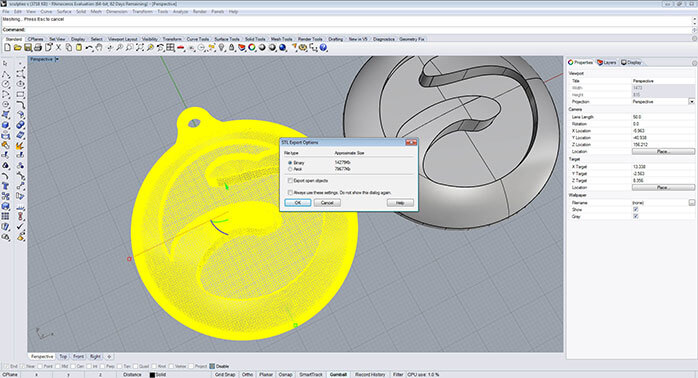
2.four. Right mesh for 3D printing
Similarly to
Airtight and compact mesh
Like
The mesh object must be meaty meaning no vertices, edges or faces around the master model. All the pieces that make up the model should have a volume, there can't be faces without any mass.
Manifold mesh
A 3D printable mesh is a correctly manifolded mesh. The term manifold defines a mesh in which all its triangular edges are straight and individually connected to one some other creating a closed volume.
Non-manifold errors are generally produced by the following reasons:
- Several faces share ane border
- Several faces share the same indicate or vertex
- At that place are some unnecessary faces intersecting the main torso of the model or at the interior of the model
Coherent mesh orientation
The faces that compose the mesh may non have the aforementioned normal orientation. That means that while 1 face
I unmarried shell
Every part that makes up your digital model needs to exist made out of merely one beat out. When you select a single part of your model, you lot normally should encounter in the control line "1 mesh added to selection" this
2.v. Mesh assay
The mesh assay tools could be actually helpful to cheque – your already exported STL from Rhino – if you want to confirm that everything is right with information technology or if you accept a model that needs to exist checked and repaired. Open mesh detection The detection of an open mesh tin can be done with the command "select open meshes

It is located in the tiptop bar in the tab "select" 'Select Meshes/
open meshes' or by typing in the command line "SelOpenMesh". The open mesh will light up if it is open. 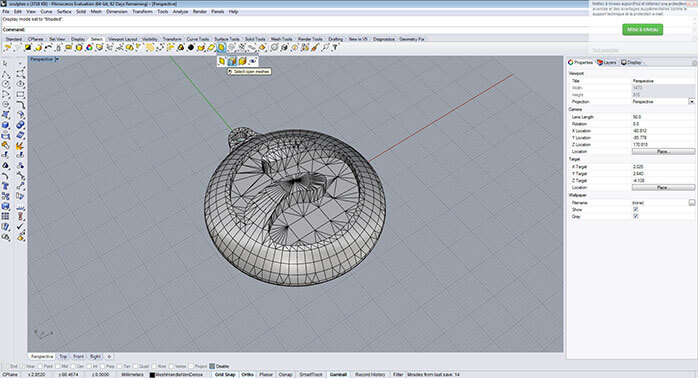
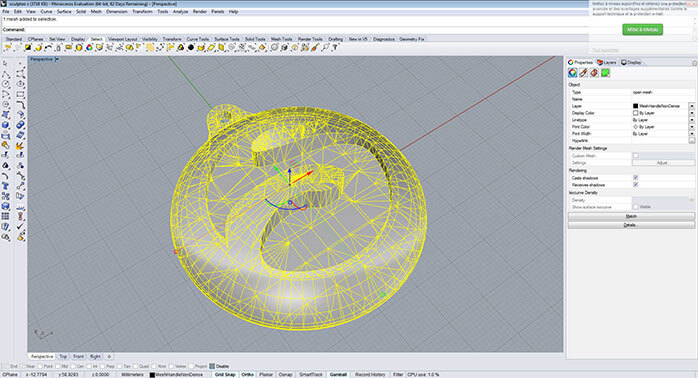 If the model is closed you will come across "No objects added to selection" in the command line. This process lets you find out which meshes are open. Once yous accept the isolated the object, yous can proceed to do the naked edges or
If the model is closed you will come across "No objects added to selection" in the command line. This process lets you find out which meshes are open. Once yous accept the isolated the object, yous can proceed to do the naked edges or
detection.
errors. The operating mode is exactly the same as the naked edges for
. The difference is that you lot volition take to switch from the naked edges case to the
edges case. You lot tin can fiind the tool that volition assist you in the main menu bar mentioning "Analyse Direction/ Prove edges". This will make a new pocket-size box popular up where you choose the object to exist
. You can also open this tool by typing in the command line "ShowEdges". It is recommended to use the tool with the volume displayed in

this will make information technology easier to find manifold errors in the interior of the object. The naked edge or manifold error volition light up the problematic face or edge. 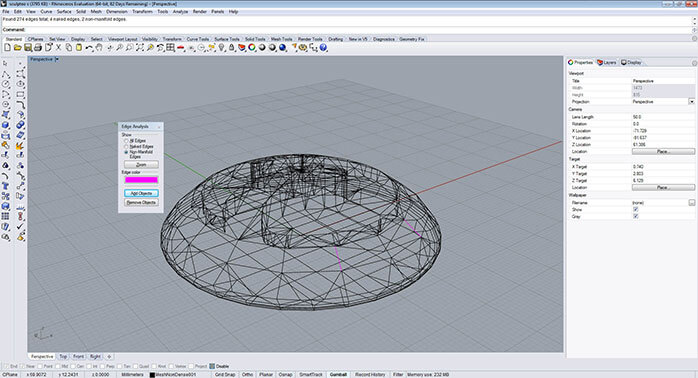 Mesh orientation analysis It is easier to identify the faces (with a normal direction) that present a problem if after running a naked edges test – you tin still run into a hole in a shaded display mode when your mesh is completely closed and there are no naked edges. This means that the face that
Mesh orientation analysis It is easier to identify the faces (with a normal direction) that present a problem if after running a naked edges test – you tin still run into a hole in a shaded display mode when your mesh is completely closed and there are no naked edges. This means that the face that
like a hole may exist, but the normal direction is inverted so the low-cal is non reflected in the return. 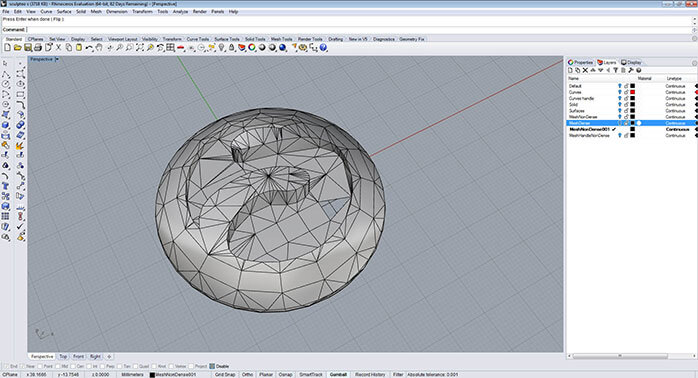 Some other style you can come across more than on the normals
Some other style you can come across more than on the normals
is past using the "Analyze direction"  tool. All directions should be oriented to the exterior of the model. This tool allows you to besides flip the normal management but it won't unify the object.
tool. All directions should be oriented to the exterior of the model. This tool allows you to besides flip the normal management but it won't unify the object. 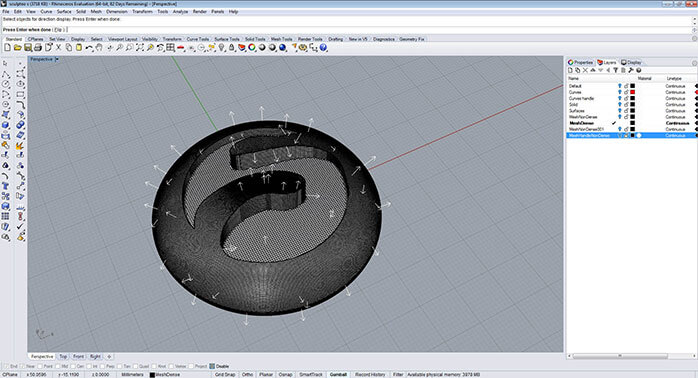 Mesh verification You can bank check if your final mesh is a 3D printable mesh by running a diagnostic bank check using the "Check objects"
Mesh verification You can bank check if your final mesh is a 3D printable mesh by running a diagnostic bank check using the "Check objects"  tool that is bachelor under the primary menu. A popup window will give yous more information nearly the model if at that place is any trouble with it – or it will say "This is a good mesh". Y'all can read the clarification and see if at that place are no more errors that were mentioned before.
tool that is bachelor under the primary menu. A popup window will give yous more information nearly the model if at that place is any trouble with it – or it will say "This is a good mesh". Y'all can read the clarification and see if at that place are no more errors that were mentioned before. 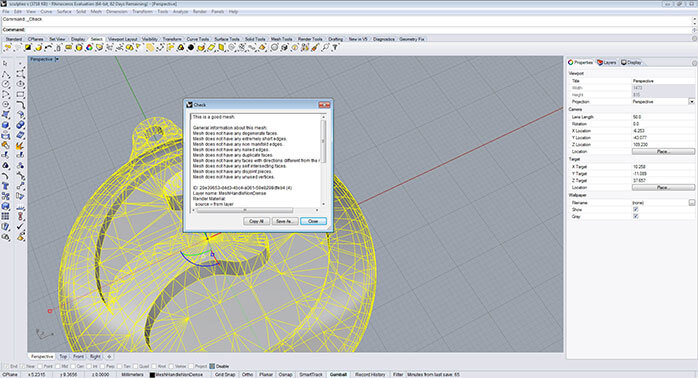
Avoid mistakes that occur when designing 3D files for 3D press on Rhino
At Sculpteo we have adult some bang-up automatic mesh repairing algorithms that you tin can easily access online through the upload environs. We can proudly say that these methods succeed in most all cases in repairing mutual mesh problems, but as they are automated repairs, you might desire to have better control on how your mesh topology should be modified post-obit any repairs. Therefore when dealing with isolated and detectable errors, information technology is amend to manually repair these errors yourself on your 3D modelling software equally in rhino, the necessary tools are provided.
The reason for manually troubleshooting errors is that no automated algorithm knows your mesh as accurately as you do.
Side by side, the tools Rhino provides to solve the most common problems with invalid meshes will exist discussed in the coming paragraphs.
iii.1. Mesh reduce
If your mesh's 'Number of Polygons' is more than than a 1.000.000, information technology will be quite difficult for Sculpteo to handle it which as well means information technology contains unnecessary details. Therefore, you need to reduce this number through the "Reduce mesh" control  .
.
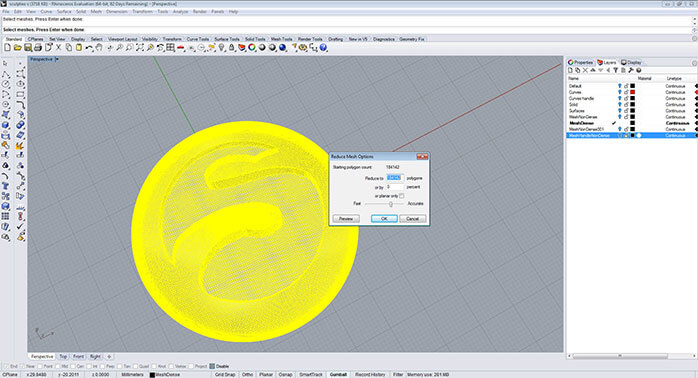
You will take to find a good remainder between your model quality detail and the polygons number considering the more you reduce the mesh the more it will become faceted.
iii.2. Mesh orientation unification
The faces belonging to the aforementioned shell of your model might non have a coherent orientation, which means that the normal direction of your faces are non the same as it was explained before in the "Coherent Mesh" section. In order to fix this issue select your model and use "Unify mesh normals" tool  this will put all the normal direction to the same side and volition eliminate the problem.
this will put all the normal direction to the same side and volition eliminate the problem.
3.3. Mesh hole fill
After running a test with "select open up meshes" and "naked edges analysis", yous have discover a hole and its location in the mesh. Equally your mesh should be closed and "watertight" to be 3D printable, the pigsty needs to be airtight. In this case you can use the "Fill pigsty" tool  .
. 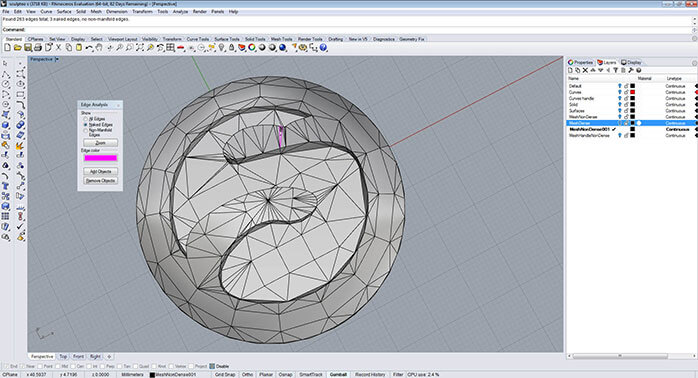
iii.4. Non manifold errors
3.5. Multishell parts
- Return to Top
Become the latest 3D printing news delivered correct to your inbox
Subscribe to our weekly newsletter to hear about the latest 3D press technologies, applications, materials, and software.
Source: https://www.sculpteo.com/en/tutorial/rhino-3d-tutorial/
0 Response to "rhino drawing on 3d model produces lines on different planes"
Post a Comment